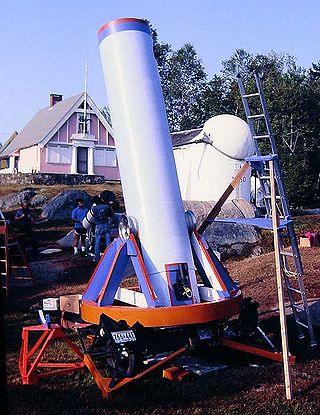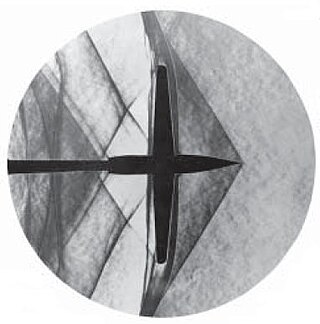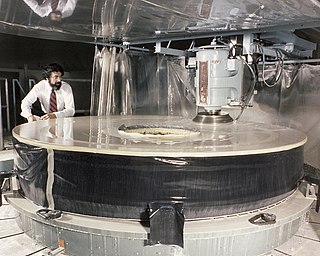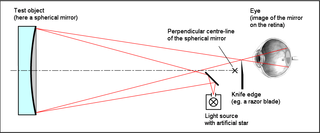Related Research Articles

Optics is the branch of physics that studies the behaviour and properties of light, including its interactions with matter and the construction of instruments that use or detect it. Optics usually describes the behaviour of visible, ultraviolet, and infrared light. Because light is an electromagnetic wave, other forms of electromagnetic radiation such as X-rays, microwaves, and radio waves exhibit similar properties.

Amateur telescope making is the activity of building telescopes as a hobby, as opposed to being a paid professional. Amateur telescope makers build their instruments for personal enjoyment of a technical challenge, as a way to obtain an inexpensive or personally customized telescope, or as a research tool in the field of astronomy. Amateur telescope makers are usually a sub-group in the field of amateur astronomy.

Joseph Ritter von Fraunhofer was a German physicist and optical lens manufacturer. He made optical glass, an achromatic telescope, and objective lenses. He also invented the spectroscope and developed diffraction grating. In 1814, he discovered and studied the dark absorption lines in the spectrum of the sun now known as Fraunhofer lines.

The history of the telescope can be traced to before the invention of the earliest known telescope, which appeared in 1608 in the Netherlands, when a patent was submitted by Hans Lippershey, an eyeglass maker. Although Lippershey did not receive his patent, news of the invention soon spread across Europe. The design of these early refracting telescopes consisted of a convex objective lens and a concave eyepiece. Galileo improved on this design the following year and applied it to astronomy. In 1611, Johannes Kepler described how a far more useful telescope could be made with a convex objective lens and a convex eyepiece lens. By 1655, astronomers such as Christiaan Huygens were building powerful but unwieldy Keplerian telescopes with compound eyepieces.

Jean Bernard Léon Foucault was a French physicist best known for his demonstration of the Foucault pendulum, a device demonstrating the effect of Earth's rotation. He also made an early measurement of the speed of light, discovered eddy currents, and is credited with naming the gyroscope.

Schlieren photography is a process for photographing fluid flow. Invented by the German physicist August Toepler in 1864 to study supersonic motion, it is widely used in aeronautical engineering to photograph the flow of air around objects.

A reflecting telescope is a telescope that uses a single or a combination of curved mirrors that reflect light and form an image. The reflecting telescope was invented in the 17th century by Isaac Newton as an alternative to the refracting telescope which, at that time, was a design that suffered from severe chromatic aberration. Although reflecting telescopes produce other types of optical aberrations, it is a design that allows for very large diameter objectives. Almost all of the major telescopes used in astronomy research are reflectors. Many variant forms are in use and some employ extra optical elements to improve image quality or place the image in a mechanically advantageous position. Since reflecting telescopes use mirrors, the design is sometimes referred to as a catoptric telescope.
Optics is the branch of physics which involves the behavior and properties of light, including its interactions with matter and the construction of instruments that use or detect it. Optics usually describes the behavior of visible, ultraviolet, and infrared light. Because light is an electromagnetic wave, other forms of electromagnetic radiation such as X-rays, microwaves, and radio waves exhibit similar properties.

In physics, the wavefront of a time-varying wave field is the set (locus) of all points having the same phase. The term is generally meaningful only for fields that, at each point, vary sinusoidally in time with a single temporal frequency.

A catadioptric optical system is one where refraction and reflection are combined in an optical system, usually via lenses (dioptrics) and curved mirrors (catoptrics). Catadioptric combinations are used in focusing systems such as searchlights, headlamps, early lighthouse focusing systems, optical telescopes, microscopes, and telephoto lenses. Other optical systems that use lenses and mirrors are also referred to as "catadioptric", such as surveillance catadioptric sensors.
Nonimaging optics is the branch of optics concerned with the optimal transfer of light radiation between a source and a target. Unlike traditional imaging optics, the techniques involved do not attempt to form an image of the source; instead an optimized optical system for optimal radiative transfer from a source to a target is desired.
Optical manufacturing and testing spans an enormous range of manufacturing procedures and optical test configurations.
Ronchi may refer to:
A wavefront sensor is a device for measuring the aberrations of an optical wavefront. Although an amplitude splitting interferometer such as the Michelson interferometer could be called a wavefront sensor, the term is normally applied to instruments that do not require an unaberrated reference beam to interfere with. They are commonly used in adaptive optics systems, lens testing and increasingly in ophthalmology.

The Houghton telescope or Lurie–Houghton telescope is a catadioptric telescope. Houghton's original design uses a two-lens corrector at the front of the telescope and a spherical mirror at the back; it was patented in 1944. Instead of the hard to make intricately shaped compound curve Schmidt corrector plate, or the heavy Maksutov-type meniscus corrector lens, the Houghton double-lens corrector is relatively easy to make.

Figuring is the process of final polishing of an optical surface to remove imperfections or modify the surface curvature to achieve the shape required for a given application.

A null corrector is an optical device used in the testing of large aspheric mirrors. A spherical mirror of any size can be tested relatively easily using standard optical components such as laser, mirrors, beamsplitters, and converging lenses. One method of doing this using a Shack cube is shown at the right, and many other setups are possible. An interferometer test such as this one generates a contour map of the deviation of the surface from a perfect sphere, with the contours in units of half the wavelength used. This is called a null test because when the mirror is perfect, the result is null. If the result is not null, then the mirror is not perfect, and the pattern shows where the optician should polish the mirror to improve it.

A Ronchi ruling, Ronchi grating, or Ronchi mask, named after the Italian physicist Vasco Ronchi, is a constant-interval bar and space square-wave optical target or mask. The design produces a precisely patterned light source by reflection or illumination, or a stop pattern by transmission, with precise uniformity, spatial frequency, sharp edge definition, and high contrast ratio.

The Foucault knife-edge test is an optical test to accurately measure the shape of concave curved mirrors. It is commonly used by amateur telescope makers for figuring primary mirrors in reflecting telescopes. It uses a relatively simple, inexpensive apparatus compared to other testing techniques.
Walter Thompson Welford was a British physicist with expertise in optics.